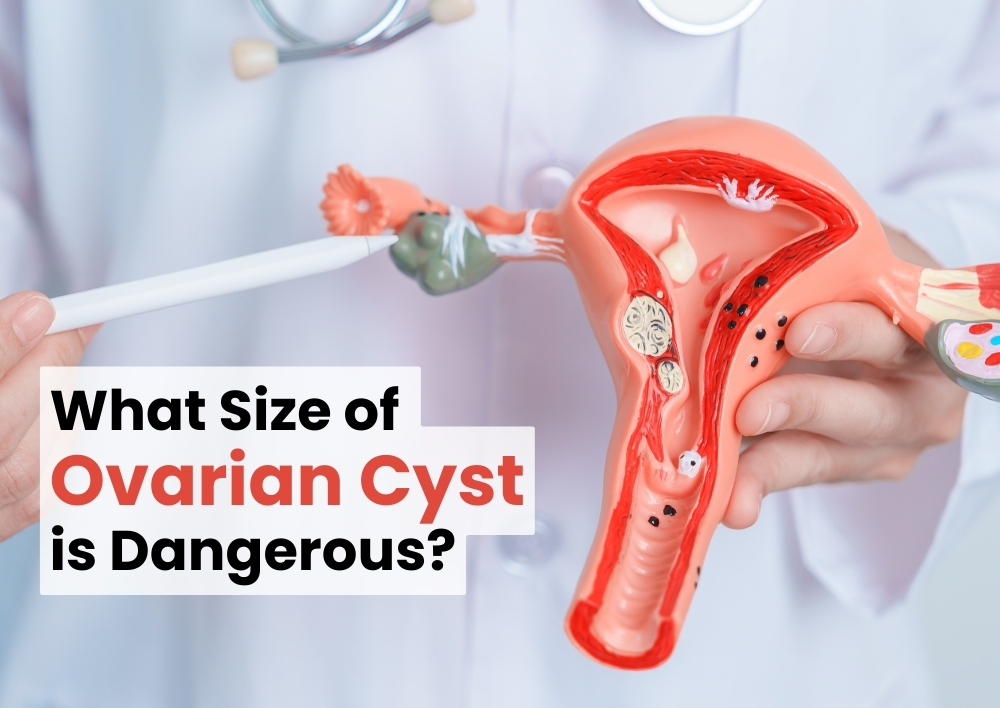Ovarian cysts are a dangerous for human body. Ovarian cysts are fluid-filled sacs or pockets that can form on or within the ovaries. Most of the cysts are benign and resolve on their own but their size is important for evaluating potential risks and complications. Explore what size of Ovarian Cyst is dangerous!
What is an Ovarian Cyst?
Ovarian cysts can develop at any age, and are often benign. It results from hormonal changes, irregularities, pregnancy, or conditions like endometriosis. Its common types are, functional cysts, dermoid cysts, endometriomas, cystadenomas, and polycystic ovary syndrome (PCOS).
Significance of Ovarian Cyst Size
The size of an ovarian cyst plays a crucial role in determining potential risks. It provides information about the need for further evaluation or treatment of cysts.
- Ovarian Cyst Risk Factors Assessment: The size of an ovarian cyst is a key factor in assessing risks associated with the cyst. The larger the cysts the higher the risk of complications it can cause.
- Indicator of Complications: The size alone doesn’t determine whether a cyst is benign or malignant, it serves as an indicator of the complications that may occur. Cysts larger in size might be more likely to cause symptoms or lead to complications that needs medical attention.
- Evaluation Need: The size of the ovarian cyst determines the need for further evaluation by healthcare professionals. Large size cysts often require additional diagnostic tests, such as imaging studies, to assess their characteristics and potential impact.
- Treatment Decision: The decision-making process depends on the size of the. Healthcare professionals recommend treatment options based on the size of the cyst and its potential to cause the symptoms or complications in the individuals.
- Monitoring Considerations: Cysts small in size may be monitored through a “watch and wait” approach, especially if they are asymptomatic but the larger ones require more proactive management and monitoring due to the increased likelihood of complications.
- Differentiating Benign and Malignant Cases: The size alone does not determine malignancy but the larger cysts may raise suspicion and prompt healthcare professionals to investigate further for potential malignancies. Smaller cysts are often benign and resolve on their own, while malignant cysts may require more aggressive interventions.
- Impact on Reproductive Health: Larger cysts may pose implications for reproductive health, affecting fertility and increasing the risk of complications during pregnancy.
- Patient Awareness: The knowledge of the cyst’s size empowers patients by allowing them to understand the potential risks associated with their condition. Patients can make informed decisions about their health by determining the most suitable course of actions.
- Guiding Treatment Strategies: The size of the ovarian cyst guides healthcare professionals in determining the most appropriate treatment strategy. The surgical intervention is recommended for larger cysts, while smaller ones may be managed conservatively.
Average Size of an Ovarian Cyst
The average size of cyst varies based on factors such as:
- the type of cyst,
- menstrual cycle stage,
- and individual characteristics.
Most cysts are so small that they measure less than 5 centimeters in diameter, and often resolve on their own without causing significant issues.
What Size of Ovarian Cyst is Dangerous?
Ovarian cysts sizes can range from a few millimeters to over 10 cm. The larger cysts, especially those exceeding 5 cm, may pose a higher risk and require medical attention. But the healthcare professionals can recommend evaluation and possible treatment for cysts of this size.
Ovarian Cyst Symptoms:
Ovarian cysts often do not cause noticeable symptoms, but some women may experience:
- Asymptomatic Nature.
- Pain in the Lower Abdomen.
- Bloating and Abdominal Discomfort.
- Changes in Menstrual Cycles.
- Pelvic Pain During Intercourse.
- Lower Back or Thigh Pain.
- Abdominal Swelling.
- Frequent Urination.
- Weight Gain.
- Nausea or Vomiting.
- Infertility Concerns.
- Severity and Persistence.
Ovarian Cysts Diagnosis : Treatment Options
All cysts require treatment but larger or symptomatic cysts may need intervention. Treatment options include:
- Watch and Wait Approach: For the smaller asymptomatic cysts, healthcare professionals may adopt a conservative “watch and wait” approach.This strategy involves the monitoring of cyst through regular check-ups and imaging tests to observe any changes in the cyst over time.
- Over-the-Counter Pain Relievers: To manage the pain and discomfort related to ovarian cysts Over-the-counter (OTC) pain relievers, such as ibuprofen, may be recommended. These medications help alleviate pain symptoms by providing relief for women experiencing mild to moderate discomfort due to cysts.
- Surgical Intervention: Surgical procedures are considered for larger cysts, persistent cysts, or those causing severe symptoms in individuals. It aims to remove the cyst and, in some cases, the affected ovary, especially if the cyst is complex, suspected to be cancerous, or poses a significant risk.
- Minimally Invasive Methods (Laparoscopy): is a minimally invasive surgical technique where a tiny camera is inserted to view and remove the cyst by small incisions. These are preferred for smaller cysts that can be accessed without the need for extensive surgery.
- Laparotomy: Laparotomy is a more traditional surgical approach that involves a larger incision to access and remove the ovarian cyst. It is chosen for larger cysts or cases where laparoscopy is not feasible or sufficient.
- Hormonal Contraceptives: Sometimes the hormonal contraceptives, such as birth control pills, may be prescribed to regulate the menstrual cycle and prevent the formation of functional cysts. It reduces the likelihood of new cyst formation.
- Cyst Drainage (Cyst Aspiration): Cyst aspiration involves draining of the fluid from the cyst using a needle and syringe. It is often guided by ultrasound.This procedure is typically reserved for cysts filled with fluid to provide relief from symptoms.
- Treatment for Underlying Conditions: If the cyst is a result of an underlying condition, such as endometriosis. The treatment may focus on addressing the primary cause to prevent the recurrence of cysts.
FAQs:
Q1. At what size is an ovarian cyst dangerous?
An ovarian cyst becomes dangerous when it exceeds 5 centimeters (2 inches) in size.
Q2. Which type of cyst is not dangerous?
Most functional cysts that results from the normal menstrual cycle are not dangerous. They typically resolve on their own.
Q3. Are ovarian cysts lifelong?
Ovarian cysts are not always lifelong;
Most functional cysts resolve on their own within a few menstrual cycles.
Conclusion
The size of ovarian cysts is important for every woman’s health. Most cysts are harmless but larger cysts are dangerous that need medical attention. Also, keep informed about what size of Ovarian Cyst is dangerous? Be aware of the symptoms. Proper care is important for early detection and appropriate management of cysts. The consultation with the healthcare professionals is very important especially for larger cysts. It ensures proper evaluation and timely intervention.
Medical Disclaimer: We only provide information for educational purposes. Do not consider it medical advice for you. In case of need, consult the healthcare professional for proper diagnosis and treatment.



